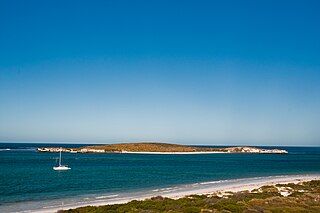
The dibbler is an endangered species of marsupial. It is an inhabitant of the southwest mainland of Western Australia and some offshore islands. It is a member of the order Dasyuromorphia, and the only member of the genus Parantechinus. The dibbler is a small, nocturnal carnivore with speckled fur that is white around the eyes.

Wedge Island is a 400-metre long wedge shaped island north of Lancelin and south of Cervantes on the Western Australian coast. The island is located just south of “the point” and approximately 15km south-east of an informal settlement known as Grey village with which it often shares a name. Both are within the Shire of Dandaragan.
The Mogumber Nature Reserve is a nature reserve in Western Australia. It is a refuge for the endangered Western Swamp Tortoise along with the Twin Swamps Nature Reserve and the Ellen Brook Nature Reserve. Twin Swamps and Ellen Brook are IUCN Protected Area Management Category IV Reserves, while the Mogumber Nature Reserve is a Category Ia nature reserve.
Burma Road Nature Reserve is a conservation area in the City of Greater Geraldton local government area of Western Australia. It lies 52 kilometres (32 mi) south of Geraldton and 20 kilometres (12 mi) east of Walkaway. It is a C-class reserve and covers an area of 6,889.5 hectares It is predominantly kwongan scrub-heath, typical of the Tathra Vegetation system of Beard and Burns. Almost all the native vegetation within a 20 km (12 mi) radius of the reserve has been cleared. There is only 11% of native vegetation remaining in the area, of which most is within the reserve.

Boullanger Island lies off the coast of Western Australia and covers an area of about 35 hectares. The nearest settlement is the mainland town of Jurien Bay. It is located within the Jurien Bay Marine Park and part of the Boullanger, Whitlock, Favourite, Tern and Osprey Islands Nature Reserve.

The Gibson Desert Nature Reserve is an 18,900 km2 nature reserve located in the Gibson Desert in central Western Australia. The nature reserve is remote and rarely visited by tourists, and is administered by the Kalgoorlie regional office of the Department of Environment and Conservation.

Lancelin Island is an island in Western Australia near Lancelin.
Whitlock Island is an island near Jurien Bay in Western Australia. It is located within the Jurien Bay Marine Park and part of the Boullanger, Whitlock, Favourite, Tern and Osprey Islands Nature Reserve.

Turquoise Coast is a name attributed to a section of the coastline of Western Australia in the vicinity of Jurien Bay.

Favorite Island is an island near Jurien Bay in Western Australia.
The Cervantes Islands are a small group of islands in Western Australia, found to the south west of Cervantes.
Queen Victoria Spring Nature Reserve is a protected area managed by the Department of Parks and Wildlife and is located approximately 200 km (124 mi) east of Kalgoorlie in the Great Victoria Desert in the Goldfields-Esperance region of Western Australia.
Jane National Park is a national park in the South West region of Western Australia, 357 km (222 mi) south of Perth. It is located adjacent to the west of the much larger Shannon National Park, in the Shire of Manjimup. It is located in the Warren bioregion.
Easter National Park is a national park in the South West region of Western Australia, 294 km (183 mi) south of Perth. It is located adjacent to the east of the much larger Hilliger and Milyeannup national parks, in the Shire of Nannup. The majority of the national park is located east of the Vasse Highway. It is located in the Jarrah Forest and Warren bioregions.
Greater Dordagup National Park is a national park in the South West region of Western Australia, 332 km (206 mi) south of Perth. It is located in the Shire of Manjimup with the South Western Highway running through the park. To the east it borders the much larger Shannon National Park. It is located in the Warren bioregion.
Niiwalarra Islands National Park is a national park in the Kimberley region of Western Australia, 250 km (160 mi) north-west of Wyndham. The national park is centered around Niiwalarra Island, formerly the Sir Graham Moore Island, but also includes some smaller near-by islands. It was declared on 4 December 2019, is located in the Shire of Wyndham-East Kimberley, and is part of the Northern Kimberley bioregion. It is the northern-most national park in Western Australia and the only one that falls into IUCN Category Ia, being classified as a strict nature reserve.








